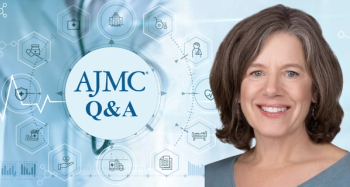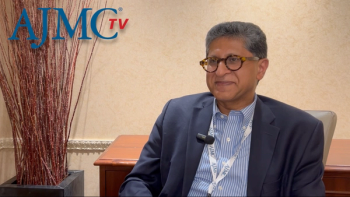
- August 2021
- Volume 27
- Issue 6
Cardinal Health Experts Outline How Research, Regulatory Approaches Can Speed Drug Approval
Cancer is no longer understood as a disease of individual organs, but as a disease of pathways—the genetic and molecular patterns that direct how cancer cells adapt within the body. The era of precision oncology means clinicians no longer treat a single type of breast cancer or lung cancer, but a growing number of subtypes defined by the biomarkers that signal how cancer will behave.
This means the study of cancer—and the development of drugs to treat it—is increasingly one of finding smaller groups of patients. It also means the clinical trial designs of the past must adapt to the challenge of treating these patients where they are. The American Journal of Managed Care® recently convened experts from Cardinal Health Specialty Solutions to discuss current challenges in cancer trial design and drug development, through the Oncology Value Coalition webinar series.
Moderator Bruce Feinberg, DO, chief medical officer at Cardinal Health Specialty Solutions, led the discussion with:
• Andy Klink, PhD, MPH, director, lead scientist, Real-World Evidence & Insights, Cardinal Health Specialty Solutions
• Ajeet Gajra, MD, MBBS, FACP, vice president and chief medical officer, Cardinal Health Specialty Solutions
• Scott Swain, PhD, MPH, director of Real-World Evidence and Regulatory Sciences, Cardinal Health Specialty Solutions
Evolution of Drug Development
Feinberg started with a discussion of the time and money required for drug development, particularly in oncology. It takes up to 12 years, and costs billions of dollars, to bring a new drug from bench to bedside. The traditional randomized control trial (RCT) design, which has been central to the development of evidence-based medicine, brings certain limitations.
“There is a problem in the representational nature of the research coming out of randomized controlled trials,” Feinberg said. “Only about 3% of the advanced patient population with cancer in the United States is participating in trials, and of those who do participate, they are young longer, they are healthier, and they are less diverse.” Patients in clinical trials also tend to be more health literate, which makes them less representative of the population. This, combined with the current understanding of cancer as a disease of pathways, has made finding new roads to drug approval necessary and, in some cases, optimal.
Swain then discussed the rise of accelerated or expedited pathways, which arose in the 1990s out the activism of HIV patients and advocates, who sought a faster means of bringing life-saving drugs to market. The traditional clinical trial paradigm of phase 1, 2, and 3 had distinct strengths in proving a drug’s safety and efficacy, but it was not a fast process. It became clear that viral load could serve as a surrogate marker, one highly predictive of survival, Swain said.
“We could get these drugs to patients sooner. So, in 1992, we get accelerated approval, and priority review,” he said. There were other pathways that came later, “but this was the beginning of the recognition that, that if you have a very strong suspicion that a drug is going to work, and you have a patient population with great need, that there are now mechanisms in place to get drugs to those patients faster,” while clinical studies continue.
Feinberg asked Gajra to comment on how 30 years after FDA launched the concept of accelerated approvals, “there doesn’t seem to be a lot of appreciation or acceptance,” among physicians. Gajra said there’s no question the randomized phase 3 trial “remains the gold standard in the minds of physicians,” and, in fact, these studies are important.
However, he said, the process “cannot be applied to every circumstance, every situation in a timely manner.” In some cases, it’s not only in the drug developer’s interest but also the patient’s, to use alternative pathways, “to get to that finish line faster.” Despite increased use of accelerated approvals, Gajra said, there remains a “generational gap” among physicians and scientists in their acceptance, because the traditional phase 1-2-3 design “has been the gold standard for so long.”
FDA Efforts to Modernize Drug Evaluation
Feinberg then asked Klink whether he was seeing any shifts toward greater use of diff erent kinds of evidence, including real-world evidence (RWE), in fi lings for drug approvals.
“Are you feeling like there is kind of the sea change, or it’s still kind of dipping a toe in the water? Feinberg asked.
Klink said the biopharma industry is gaining comfort “in exploring some of these ideas,” with the main advantage being the amount of time that could be saved with RWE approaches. Swain noted that in the 1960s, when the phase 1-2-3 design was implemented, “there was a lot of confusion at the time—nobody really knew what to do.”
“It reminded me a lot of how it was at FDA in 2016, when 21st Century Cures was passed—all the real-world evidence started flooding in; nobody really knew what they were doing. There was no guidance out,” he said. Over the next few years, the agency has provided more direction, particularly with its 2018 framework document.1 Swain noted that the accelerated approval options that arose in the 1990s came out of a specific need, and it took time to adapt them for other types of drugs.
Today, he said, there are alternative study designs, accelerated review, and accelerated approval. More critically, Swain said, “We’ve gone from a place where there was really one way to get a drug approved—you go through phase 1, then phase 2 and phase 3, and then you go through the normal review process. There’s now almost an infinite number of combinations. … You can really customize it based on your specific indication and your specific product.” He then reviewed the terms that have become well-known in oncology drug development. Fast track and breakthrough therapy designations are designed to increase communication with FDA, and make developers eligible for rolling and priority review. Swain explained that these are given when a drug is designed to treat a very serious disease for which no treatment exists or for a treatment that is far superior to a current treatment. Priority review can reduce decision time on a new drug application from 10 months to 6 months.
Adaptive study designs, he said, allow developers to prespecify study modifications than can allow for changing a dose or enrolling more patients from a certain subgroup if they have a stronger response. This is essential as cancer research moves beyond organ-level disease and dives deeper into looking at biomarkers; developers who see a group of patients responding to a drug can enroll more of them in a study. In decentralized trials, providers make greater use of telemedicine and form partnerships with local health care providers. “So instead of going into the clinical site to see the physician, you may just see them on your phone or your iPad for most of your clinical visits,” Swain said. “You may receive care locally; you may receive care in your home.” Feinberg asked Gajra what happens when the early hope of an accelerated approval doesn’t pan out. In the past year, FDA has addressed cases where accelerated approvals based on phase 2 results were withdrawn after results did not hold up in a later study.
“The spirit and the purpose of the accelerated approval track was appropriate when it was coined, and I think it’s appropriate today,” Gajra said. “There’s extreme dissemination of information compared with 30 years ago—so patients, families, advocacy groups—everyone’s very aware of any positive development anywhere in the world. And they certainly would like access to a given agent that might provide them some hope or fighting chance.”
The Arrival of RWE
Klink reviewed how the 21st Century Cures Act of 2016 called on FDA to develop frameworks for using RWE in drug development. In the early 2000s, he said, it became clear that health systems were sitting on huge data sets that could be tapped for insights to identify patterns and drug signals. The Sentinel pilot program, which took place than 10 years ago, was an important milestone in using federal data to track drug safety.
“The quality and reliability of our real data has improved,” Klink said, and evaluations for efficacy as well as safety began. “Even today, we can look at the COVID-19 vaccine rollout in the United States, where potential safety signals have been identified in a broader US population of those who receive the vaccine in the FDA is emergency with authorization. And given the low rates of these potential events, millions of doses were really required in order to identify these events, which may not have been possible in a traditional RCT setting.”
FDA’s framework on real-world evidence, which outlined upcoming guidance for regulatory decision making, covers key areas, Klink said: (1) how to assess for real data sources; (2) study design considerations; and (3) analysis of world data.1
Real-world data (RWD), he said, covers “data related to the patient health status or data relating to the delivery of health care routinely collected in a variety of sources, typically in routine clinical practice.” RWD can include electronic health records, medical claims, and billing data, as well as patient generated data, such as survey or data from wearables, such as a Fitbit.
“One passive method of collecting real-world data is through routine medical encounters, where anytime a patient visits a health care facility, a claim may be generated, containing diagnoses, drug information and procedures, and that forms the basis of a longitudinal picture of health care encounters for that patient,” Klink said.
COMPARING RCTS TO RWE. He then compared the benefits of RCTs compared with the use of RWE. "Causal inference is straightforward in RCTs,” he said, but this can be a challenge with RWE, “due to randomization of treatment assignments between the 2 groups. RCTs have very rigid protocol, defined endpoints, and clear instructions on how they’re measured, Whereas in the [real-world data] setting, end points could be measured in precisely or using a variety of methods.”
Using real-world data can come into play when an external control arm could be used alongside a single-arm trial. The external control arm, “may come about in a few different settings in which a parallel controller might not be feasible, or ethical. That might happen when the effect size of a new drug is expected to be large based on preliminary data, or the standard of care doesn’t exist.”
Using RWE in the Regulatory Process
Convincing regulators to accept RWE as proof of efficacy can still be an uphill battle. But the pandemic has shown the need for greater flexibility and the need for alternative formats for drug development. RWE is still underutilized, Gajra said, “and I think some of this has just to do with the relative newness and the apprehensions.”
“Manufacturers, of course, want to stick with a time-tested paradigm,” he said, given the billions of dollars at stake. Lack of expertise in developing the data is another concern. “The drug development community needs to be educated and needs to understand how and where to best use real-world evidence, which can shorten time lines, which is their goal and can cut down on expenses, which is also their goal.” The key, he said, is to reach out to FDA early in the process. “This all has to be a part of that protocol,” he said. “It has to be at the design stage. Otherwise, it’s too late.”
PMR VS PMC. Swain then explained the difference between these postmarketing elements that may be required to obtain approval under an accelerated timeline. A postmarketing requirement (PMR) is a stricter standard than a postmarketing commitment (PMC), but both call for additional analyses that FDA will expect before granting full approval.
WHAT FDA WANTS TO SEE. Swain explained that when the first RWE studies were offered in regulatory processes, sometimes arrived without warning, and FDA if there was no prespecified protocol, the work was considered an ad-hoc analysis. The key questions, Swain said, are the following:
• Is there a prespecified protocol? Swain recommends giving FDA a proposal first, then a protocol.
• Do the scientific and regulatory questions align? In other words, does the RWE study population match the target population for the therapy. Will the study address regulatory questions and concerns? Are exposures and outcomes properly defined and identified?
Use of RWE presents its own challenges, including the risk of bias. Klink agreed with Swain that finding the right data set to answer the right regulatory question is essential. As Feinberg said, the key to using RWE is to talk to FDA “early and often.”
COVID-19 and Decentralized Trials
Gajra noted the problem of the historic lack of representation in clinical trials. In oncology in
particular, trial populations have not reflected the reality that cancer affects older adults. “As people get older, they have less mobility, they have less social support,” he said.
Thus, enrolling these patients in trials becomes difficult, and when accrual is poor, it costs time and money for both the pharmaceutical company and for patients who need the drug. A more patient-centric approach, he said, is the decentralized trial, which makes it easier on the patient by allowing data collection to occur in their local physician’s office or even in their own homes. Patients are spared from having to travel for minor checkups or to sign paperwork. “There is no reason why it cannot be an electronic consent,” Gajra said.
FINDING SMALL GROUPS OF PATIENTS. The decentralized approach, developed to study patients with rare diseases, will be needed for future cancer research, as cancer will increasingly be studied among small groups of patients with certain molecular markers. As with the accelerated approval process, Gajra said, protocols must be spelled out in advance. There are regulatory hurdles, he said, “but they are not insurmountable.”
And for patients, there’s a significant improvement in quality of life. “If it’s infusion therapy, sure, patients will always have to a clinic,” he said. “But it doesn’t have to be a clinic that is 100 miles away, or from Staten Island to Upper East Side of Manhattan.”
With the number of oral therapies, Gajra said, “there’s no excuse for not having decentralized design.” Has COVID-19 helped move the ball forward? Swain said the situation with COVID-19 was unique, because federal funding allowed manufacturing of the vaccines to start “before we had proof they worked.…But I think that could actually be implemented in in cancer therapies, for example, where you know, you have a home run drug.”
“I think what COVID really brought us was the acceleration of the decentralized design, because the same way that it influenced e-commerce, the same way that it influenced telework, it suddenly became necessary—and everybody figured out that we can do it, and then it works well.” Swain said. “There’s evidence now that patients prefer it and the providers prefer it, because it’s much more convenient.”
Feinberg asked if the recent controversy over some accelerated approvals would set back the cause of an expedited process. Swain said he did not think so. “I think what it really comes down to is the quality of your surrogate marker,” he said. “I think that the call for amendments to the accelerated approval program is probably justified; I think there are things that could be done to improve it. But rather than getting rid of something, rather than taking a step back, I think it’s better to take a step forward and just improve the process.”
Reference
1. Framework for FDA’s Real-World Evidence Program. FDA. December 2018. Accessed July 31, 2021. https://www.fda.gov/media/120060/download
Articles in this issue
over 4 years ago
August 2021: Targeted Therapy & Immuno-Oncologyover 4 years ago
ASCO, COA Release Updated Standards for Oncology Medical HomeNewsletter
Stay ahead of policy, cost, and value—subscribe to AJMC for expert insights at the intersection of clinical care and health economics.







































